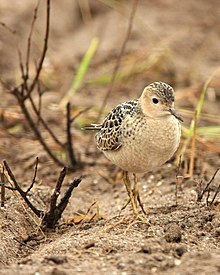Buff-breasted sandpiper
| Buff-breasted sandpiper | |
|---|---|
 |
|
| Scientific classification | |
| Kingdom: | Animalia |
| Phylum: | Chordata |
| Class: | Aves |
| Order: | Charadriiformes |
| Family: | Scolopacidae |
| Genus: |
Tryngites (disputed) Cabanis, 1857 |
| Species: | T. subruficollis |
| Binomial name | |
|
Tryngites subruficollis (Vieillot, 1819) |
|
 |
|
| Range of T. subruficollis Year-Round Range Summer Range Winter Range | |
The buff-breasted sandpiper (Tryngites subruficollis) is a small shorebird. Tryngites is from Ancient Greek trungas, a white-rumped wading bird mentioned by Aristotle but not further identified. The species name subruficollis is from Latin sub, "near to" and collum, "neck". It is a calidrid sandpiper and currently considered to be the only member of the genus Tryngites. It may belong in the genus Calidris itself, or more precisely with the small species thereof that could possibly be split into a distinct genus. Depending on whether this would include the curlew sandpiper or not, the name Erolia would or would not, respectively, apply.
This species is brown above, and has a buff face and underparts in all plumages. It has a short bill and yellow legs. Males are larger than females. Juveniles resemble the adults, but may be paler on the rear underparts.
T. subruficollis breeds in the open arctic tundra of North America and is a very long-distance migrant, spending the non-breeding season mainly in South America, especially Argentina.
It migrates mainly through central North America, and is uncommon on the coasts. It occurs as a regular wanderer to western Europe, and is not classed as rare in Great Britain or Ireland, where small flocks have occurred. Only the pectoral sandpiper is a more common American shorebird visitor to Europe.
This species nests as far north as Canada including Alaskaon the ground, laying four eggs. The male has a display which includes raising the wings to display the white undersides, which is also given on migration, sometimes when no other buff-breasted sandpipers are present. Outside the breeding season, this bird is normally found on short-grass habitats such as airfields or golf-courses, rather than near water.
...
Wikipedia

